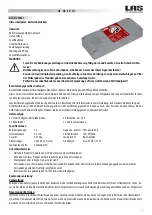
Section 2
2.1
OPERATION
The Series 302 devices have an optional digital LCD display that works as a local operator interface
for basic factory pre-programmed functions or for personalized user functions through the host
system remote tool in the engineering and/or maintenance station. To accomplish these
configurations through local adjustment, use the SD-1 magnetic tool for local adjustment.
In a more complete and friendly way, all configuration, operation and diagnosis can be
accomplished remotely, by using, for example, a configurador, an engineering or maintenance
console. For more details consult the Syscon network manual configurator or the AssetView asset
manager.
The configuration is composed of the automatic association of addresses for the H1 network device,
the tag attribution and the selection or instantiation of function blocks that will be executed inside the
device. And based on these, build the control strategies that it is made by selecting the blocks, inter-
connecting and adjusting the internal parameters in order to get the required operation.
The local and remote operation interfaces also enable monitoring the performance of the variables,
such as process variables and setpoint. These variables depend on their use and can be accessed
in a single communication.
The management of acyclic events is performed automatically. When alarms and other critical
events occur, the function block informs the user directly, without the need for the interface to
execute a scan periodically to determine if there is an alarm condition. It takes some time for the
recognition to be received. This will happen even if the alert condition disappeared and it will be
reported by the device. If it is not recognized in a given period, the event report will be issued.
Similarly, the communication informs automatically the configuration changes involving statistical
data. An event is generated by an internal mechanism when a change occurs, so the host won't
need to constantly check for a possible system overload.
Through the scheduled communication, the transfer of connection parameters between function
blocks can be synchronized with the block execution. Thus, the block that uses an input parameter
can receive this data before running the algorithm block.
Due to the configuration and alarm mechanism, the so-called "non-operational traffic", has been
minimal, with more time for operational traffic and control improvement.
After being configured, the system saves the parameter tags and names to allow for an optimized
communication.
Using the device function blocks, the speed can increasingly be improved. For example, using the
PID block for control, there is one communication less , unlike the control done by another device.
This decreases the duration of the control application and therefore the network macro-cycle.
LCD Indicator
The LCD indicator displays each function block parameter that is user-selectable. Some of them can
be changed by local action, according to the user configuration and the parameter properties.
When the user chooses a variable, the display shows the parameter mnemonic, its value and status
when it is different from “
good
”. The field and status indicators are explained in Figure 2.1.
















































